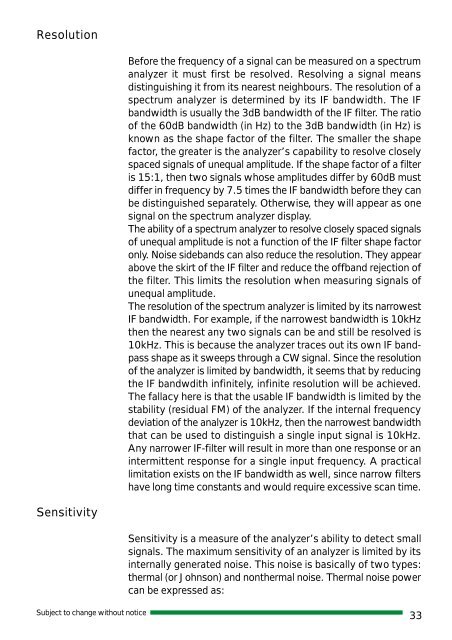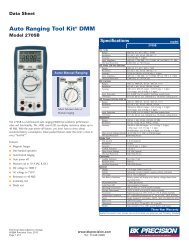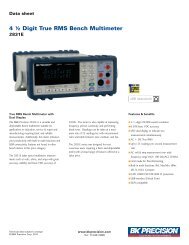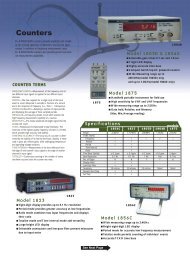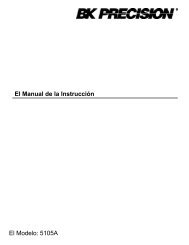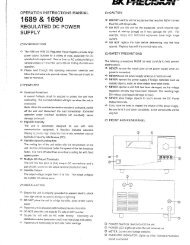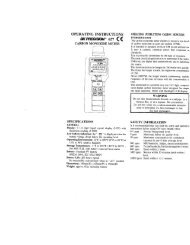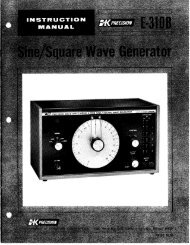2635 manual - BK Precision
2635 manual - BK Precision
2635 manual - BK Precision
You also want an ePaper? Increase the reach of your titles
YUMPU automatically turns print PDFs into web optimized ePapers that Google loves.
Resolution<br />
Before the frequency of a signal can be measured on a spectrum<br />
analyzer it must first be resolved. Resolving a signal means<br />
distinguishing it from its nearest neighbours. The resolution of a<br />
spectrum analyzer is determined by its IF bandwidth. The IF<br />
bandwidth is usually the 3dB bandwidth of the IF filter. The ratio<br />
of the 60dB bandwidth (in Hz) to the 3dB bandwidth (in Hz) is<br />
known as the shape factor of the filter. The smaller the shape<br />
factor, the greater is the analyzer’s capability to resolve closely<br />
spaced signals of unequal amplitude. If the shape factor of a filter<br />
is 15:1, then two signals whose amplitudes differ by 60dB must<br />
differ in frequency by 7.5 times the IF bandwidth before they can<br />
be distinguished separately. Otherwise, they will appear as one<br />
signal on the spectrum analyzer display.<br />
The ability of a spectrum analyzer to resolve closely spaced signals<br />
of unequal amplitude is not a function of the IF filter shape factor<br />
only. Noise sidebands can also reduce the resolution. They appear<br />
above the skirt of the IF filter and reduce the offband rejection of<br />
the filter. This limits the resolution when measuring signals of<br />
unequal amplitude.<br />
The resolution of the spectrum analyzer is limited by its narrowest<br />
IF bandwidth. For example, if the narrowest bandwidth is 10kHz<br />
then the nearest any two signals can be and still be resolved is<br />
10kHz. This is because the analyzer traces out its own IF bandpass<br />
shape as it sweeps through a CW signal. Since the resolution<br />
of the analyzer is limited by bandwidth, it seems that by reducing<br />
the IF bandwdith infinitely, infinite resolution will be achieved.<br />
The fallacy here is that the usable IF bandwidth is limited by the<br />
stability (residual FM) of the analyzer. If the internal frequency<br />
deviation of the analyzer is 10kHz, then the narrowest bandwidth<br />
that can be used to distinguish a single input signal is 10kHz.<br />
Any narrower IF-filter will result in more than one response or an<br />
intermittent response for a single input frequency. A practical<br />
limitation exists on the IF bandwidth as well, since narrow filters<br />
have long time constants and would require excessive scan time.<br />
Sensitivity<br />
Sensitivity is a measure of the analyzer’s ability to detect small<br />
signals. The maximum sensitivity of an analyzer is limited by its<br />
internally generated noise. This noise is basically of two types:<br />
thermal (or Johnson) and nonthermal noise. Thermal noise power<br />
can be expressed as:<br />
Subject to change without notice<br />
33


